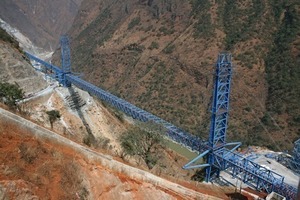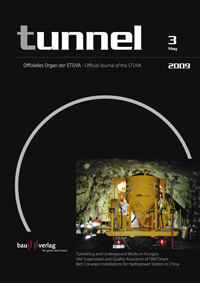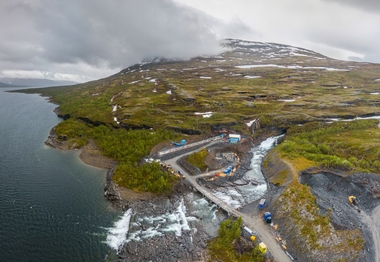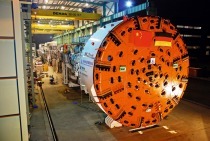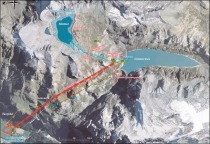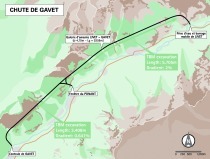Belt Conveyor Installations for Jinping II Hydro-power Station in China
Energy is to be generated in China in the Province of Sichuan with the help of 21 hydropower stations. The 2 hydropower stages Jinping I and II also belong to this overall scheme. Towards this end a complicated system of various tunnels and headings, whose muck is removed via a well thought-out conveyor belt system, is being developed.
The Yalong River one of the main tributaries of the Yangtze is situated in the southwest of the Province of Sichuan. It often flows in deep gorges through the mountainous Tibetan high plateau and the Sichuan lowlands. In its final stage the energy provided by 1,571 km of river with a difference in height of more than 2,800 m is to be used by 21 power stations to produce power.
The Ertan Hydropower Development Company Ltd. (EHDC) has been commissioned to build the series of hydropower stations. Following the completion of the Ertan Dam with its corresponding power station at present the 2 hydropower stages Jinping I and II are under construction on the central reaches of the Yalong.
The Jinping II hydropower station will take advantage of the drop height of a 120 km long loop of the river. The maximum output amounts to 4,800 MW. The plant has been designed completely underground as a cavern power station. The motive water lines consist of 4 parallel running pressure tunnels each roughly 17 km long with 12.4 m external diameter. A drainage tunnel with an external diameter of 6.0 m runs parallel to these tunnels. This is to be used as an aid for construction in order to be able to drain the karstified rock and increase safety while driving the main tunnels. The material ex-cavated in order to build the pressure tunnels and the drainage tunnel amounts to some 20 mill. t. The 4 drives on the east side of the loop in the river for the pressure tunnels and the drainage tunnel are opened up by means of a joint access heading. A major part of the excavated material stemming from the 5 drives – 2 drill + blast drives and 3 TBM drives – must be removed via this
access heading and all the material used for safety and lining purposes brought in. From the logistics viewpoint the access heading thus represents an essential link in the overall construction site chain.
As China has an enormous need for power the time schedule is extremely ambitious: the first drill + blast excavations for the pressure tunnels began in 2007 and the 2 TBM drives started in winter 2008. The hydropower station is scheduled to be completed by 2014. High rates of advance are required in order to adhere to this construction programme. It is intended that the TBM drives attain an average monthly rate of 600 m. In order to facilitate such high rates of advance up to 5,600 t per hour of excavated material has to be transported through the access heading and reach its final location after covering some 6 km. There the excavated material will partly be prepared and reused as concrete aggregate. The rest of the material will be utilised to fill a side valley of the Yalong River almost up to 300 m in height and over a length of more than 1 km.
In 2006 the Marti Technik AG was invited by the EHDC to devise a concept for handling these excavated materials. A study revealed that the transport quantities that were foreseen could only be coped with by means of extremely efficient belt conveyor installations both in the access heading as well as en route to the final dumping site. The study formed the basis for a series of tenders for the EHDC. These included one for the installation of the TBM drives – tunnel boring machine, backup, ventilation system and tunnel belt conveyor system – as well as the tender for the entire external belt system between the pressure water tunnel drives up to the final tip. Whereas submissions for the driving installations were invited internationally, the tendering process for the external belt conveyor was confined to China.
Marti Technik worked out offers for both packages, partially in conjunction with Chinese partners. The outcome resulted in 2 orders: one for supplying the tunnel belt conveyor system and a second to deliver and install the complete external belt conveyor.
Tunnel Belt Conveyor System
The tunnel belt conveyor system for pressure tunnel No. 3 with an excavated diameter of 12.4 m driven by a tunnel boring machine was supplied by Marti. The system can convey 1,800 t/h. The belt width amounts to 1.2 m. After accomplishing the drive the length of the conveyor belt will probably extent to 14,700 m. The tunnel belt conveyor system comprises an assembly station for the bearing structure on the TBM back-up, the actual tunnel belt conveyor system itself and a belt storage unit with drive station. After 7.7 driven km an intermediate station (booster) has to be installed to assure that the material is conveyed over the entire length of the excavation without excessive tensile forces acting on the belt. In its completed stage the entire installed capacity of this system will amount to 2,800 kW. The tunnel belt conveyor system is one of the most powerful ever produced. Through combining the belt storage unit with the specially developed assembly station for the bearing structure on the TBM back-up it is possible to lengthen the conveyor belt largely independent of the TBM excavation. The drive has to be interrupted only after every 250 m corresponding to a time period of 12 days – commensurate with the projected average rate of advance of the TBM of 600 m per month – in order to replenish the belt storage unit.
The package in question includes the engineering, supplying all mechanical and electrical components, the control unit for the system as well as supervision of assembly. Assembly itself and operation of the system are undertaken by the tunnelling crews. In contrast to the model that is customary in Europe the client was responsible for devising all the driving installations for the mechanised excavations and made them available to the tunnelling contractors.
External Belt Conveyor
Whereas the tunnel belt conveyor system largely represents a standard product in spite of its great length and the high installed capacity, the external belt conveyor is a tailor-made solution, which includes a number of special features.
The EHDC did not invite tenders to be submitted internationally for this installation but confined them to China. At the same time the EHDC laid down ambitious specifications both regarding deadlines as well as technical requirements. For example the conveyor belts for the external belt conveyor had to be devoid of transfer points over the 6 km between the access heading and the final tip while the haulage capacity had to amount to 5,600 t/h. In addition it was also essential to ensure that 600 t/h of excavated material converted into concrete aggregate could be transported back.
During the very short tendering phase the Marti Technik evolved a technical solution. The entire system as from the transfer stations for the excavated material in the access heading right up to the tip is logically planned with 2 lines. This first of all enables to make sure that the excavated material suitable for reutilisation can be transported separately from unsuitable material and secondly that driving is possible – at least to some extent – even when the belt is being inspected or serviced. The following requirements had to be fulfilled:
– Acceptance of the excavated material at the tunnel belt conveyors.
At this point a decision is reached about the function or quality of the material, whether it is suitable for being prepared as aggregate. The excavated material can be transferred on to one of the conveyor belt lines via a reversible plate belt.
– Two parallel conveyor belts each with 2,800 t/h capacity and 1.2 km in length in the access heading.
These conveyor belts have the task of taking over the material from the excavations and removing it from underground. The belt width amounts to 1.2 m. Both belts are set on a bridge structure. This structure is suspended beneath the crown in the access heading. This is in order to comply with an EHDC regulation that no supports are permitted to be used in the access heading so that its floor area is kept completely free for traffic by rail and tyred vehicles.
– Two parallel external belt conveyors over a distance of 6.2 km.
These belts each with a capacity of 2,800 t/h carry the excavated material from the transfer point in front of the access heading’s portal up to the foot of the tip. The high transport capacity and the associated choice of wide conveyor belts considerably restricted the parameters for the layout of the route. As a result the minimum horizontal curved radius had to be confined to 1,200 m and the maximum gradient of the roadway to 14° (25 %). On the lower belt of one of the conveyors 600 t of concrete aggregates is transported back from the gravel works at the tip to the portal of the access heading. The entire installation is supported as this was the only possible way to assure suitable alignment for the conveyor belt in extremely steep terrain. Nonetheless 4 bridges spanning between
62 and 200 m had to be set up. Two of these bridges were designed as suspension bridges, the others as multi-span continuous beam bridges.
– A belt conveyor for tackling the tip.
With 2 parallel conveyor belt lines each 1 km long the material is roughly distributed over the area of the tip. The belts are continuously lengthened as the tip grows in size. This required special solutions such as pretensioned discharge stations.
– A further belt conveyor system with a length of 430 m, which carries the concrete aggregates from the main plant to the intermediate storage facility some 60 m higher.
The order did not simply embrace conceiving and producing the sophisticated belt conveyor systems but also the planning and execution of all essential foundation engineering work. This included all foundations as well as the construction of a 2 km long conveyor belt tunnel.
The challenges encountered during this project were manifold. Demands on the technology were high. In addition there were special features to be considered in conjunction with the project: the space conditions on the remote construction site were most constricted. The road within the site had to be closed for practically all assembly applications for the belt conveyors. The amounts of steel required meant that a field factory had to be established. The associated logistical and qualitative challenges constantly led to protracted and tricky discussions with the Chinese partners. Even importing the in part special belt conveyor components continuously raised new issues for experienced customs agents.

